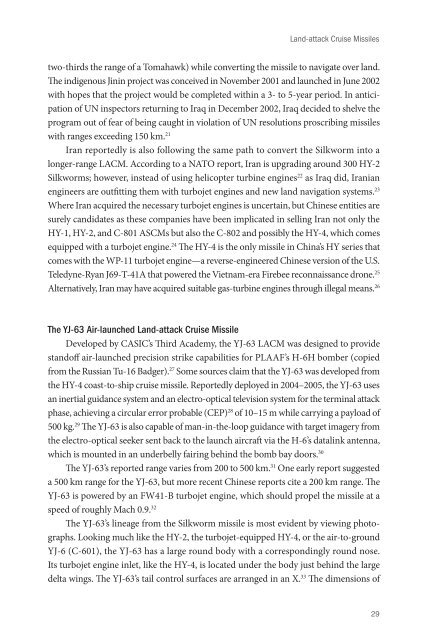Create successful ePaper yourself
Turn your PDF publications into a flip-book with our unique Google optimized e-Paper software.
Land-attack Cruise Missiles<br />
two-thirds the range of a Tomahawk) while converting the missile to navigate over land.<br />
The indigenous Jinin project was conceived in November 2001 and launched in June 2002<br />
with hopes that the project would be completed within a 3- to 5-year period. In anticipation<br />
of UN inspectors returning to Iraq in December 2002, Iraq decided to shelve the<br />
program out of fear of being caught in violation of UN resolutions proscribing missiles<br />
with ranges exceeding 150 km. 21<br />
Iran reportedly is also following the same path to convert the Silkworm into a<br />
longer-range LACM. According to a NATO report, Iran is upgrading around 300 HY-2<br />
Silkworms; however, instead of using helicopter turbine engines 22 as Iraq did, Iranian<br />
engineers are outfitting them with turbojet engines and new land navigation systems. 23<br />
Where Iran acquired the necessary turbojet engines is uncertain, but Chinese entities are<br />
surely candidates as these companies have been implicated in selling Iran not only the<br />
HY-1, HY-2, and C-801 ASCMs but also the C-802 and possibly the HY-4, which comes<br />
equipped with a turbojet engine. 24 The HY-4 is the only missile in China’s HY series that<br />
comes with the WP-11 turbojet engine—a reverse-engineered Chinese version of the U.S.<br />
Teledyne-Ryan J69-T-41A that powered the Vietnam-era Firebee reconnaissance drone. 25<br />
Alternatively, Iran may have acquired suitable gas-turbine engines through illegal means. 26<br />
The YJ-63 Air-launched Land-attack Cruise Missile<br />
Developed by CASIC’s Third Academy, the YJ-63 LACM was designed to provide<br />
standoff air-launched precision strike capabilities for PLAAF’s H-6H bomber (copied<br />
from the Russian Tu-16 Badger). 27 Some sources claim that the YJ-63 was developed from<br />
the HY-4 coast-to-ship cruise missile. Reportedly deployed in 2004–2005, the YJ-63 uses<br />
an inertial guidance system and an electro-optical television system for the terminal attack<br />
phase, achieving a circular error probable (CEP) 28 of 10–15 m while carrying a payload of<br />
500 kg. 29 The YJ-63 is also capable of man-in-the-loop guidance with target imagery from<br />
the electro-optical seeker sent back to the launch aircraft via the H-6’s datalink antenna,<br />
which is mounted in an underbelly fairing behind the bomb bay doors. 30<br />
The YJ-63’s reported range varies from 200 to 500 km. 31 One early report suggested<br />
a 500 km range for the YJ-63, but more recent Chinese reports cite a 200 km range. The<br />
YJ-63 is powered by an FW41-B turbojet engine, which should propel the missile at a<br />
speed of roughly Mach 0.9. 32<br />
The YJ-63’s lineage from the Silkworm missile is most evident by viewing photographs.<br />
Looking much like the HY-2, the turbojet-equipped HY-4, or the air-to-ground<br />
YJ-6 (C-601), the YJ-63 has a large round body with a correspondingly round nose.<br />
Its turbojet engine inlet, like the HY-4, is located under the body just behind the large<br />
delta wings. The YJ-63’s tail control surfaces are arranged in an X. 33 The dimensions of<br />
29


